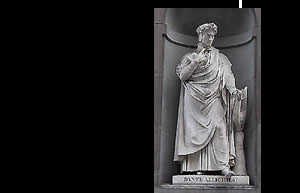|
Italian Literature
The Cantico delle Creature (Song of All
Creatures) written by St. Francis of Assisi in 1225 is the
earliest known literary work written in the Italian language.
In the XIVth cent. lived and worked three of the greatest
figures in Italian literature: Dante, Petrarch
and Boccaccio, father of the novel, whose Decameron
is a mirror of merchant-class life of the times and characterises
single individuals by focussing on the things they do; this
work became a genre model for centuries that followed. In
the XVth and XVth cents. poems of chivalry were much in vogue,
comprising epic tales of heroic deeds in faraway times: Torquato
Tasso in his Gerusalemme Liberata (Jerusalem
Freed) of 1575 revived the genre into a veritable masterpiece
of its kind. Treatises also abounded during these two centuries
and Niccolò Machiavelli in his Principe
(The Prince) of 1513 describes this role figure in
a realistic manner: his political merits are his strong point,
along with cynicism and resolution. Machiavelli is famed for
paving the way towards politics as a separate branch of learning
conceived of as a skill to be acquired for solving practical
problems. The XVIIIth cent. saw the reform of the theatre
with Goldoni, and also the tragedies of Vittorio
Alfieri who staged the tale of a “tyrant” fired
by vehement bursts of passion, torn between moral duty and
the desire for power that leads to his final self destruction.
There then followed the extraordinary flowering of Romanticism
that permeated the literature of the early XIXth cent.
A new language soon emerged, epitomised in Manzoni’s
Promessi Sposi (The Betrothed) of 1840, whose
style was no longer literary but featured everyday language
that was comprehensible to the masses; the story genre was
new as well, dealing with reality as seen and lived by humble
folk. So it was that Manzoni wrote the first great
novel in Italian literature, setting a precedent for Italian
realism with writers focussing on the present moment and on
aspects of everyday life. The idea of making reality jump
out from the page “as if it appeared by itself”
can be seen for example in the Malavoglia (Reluctance)
written in 1880 by Giovanni Verga with very precisely
chosen linguistics and form. In the late XIXth cent., in a
context of existential unrest better known as Decadentism,
new artistic tendencies began to take shape: for forty years
D’Annunzio dominated Italian literary tastes and
the disquieting, contradictory charms of his works still appeal
to many to this day. Andrea Sperelli, the lead character in
Piacere (Pleasure) of 1889, is a humane yet cynical,
dissolute type, a dandy fired by aspirations to beauty who
swears by elegance and outward appearances as ends in themselves,
shunning all that is mediocre and banal; this “Superman”
hero’s provocative, amoral behaviour and sentimental,
erotic and intellectual adventures are told in an elaborate,
refined style of language that reflects the settings they
describe.
Pascoli set the scene for modern Italian
poetry: the “fanciullino” went beyond everyday reality
to discover a world of secrets and mystery that is both disconcerting
and dominated by the idea of Death.
home
|
|











